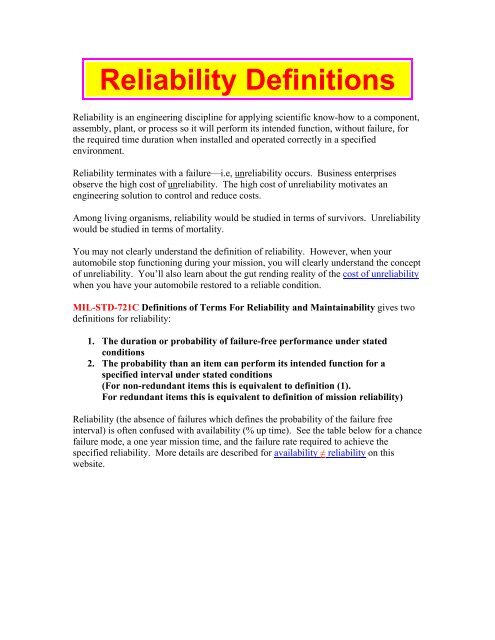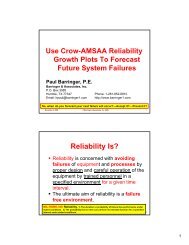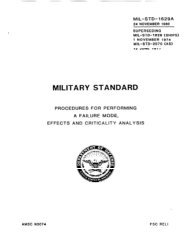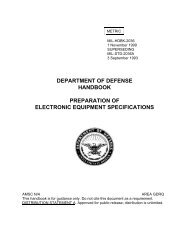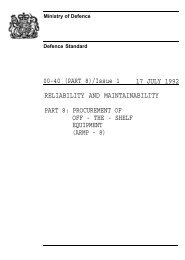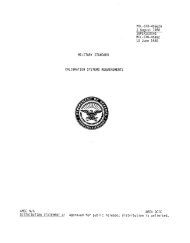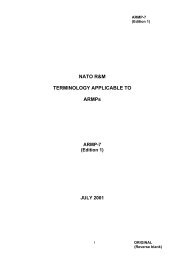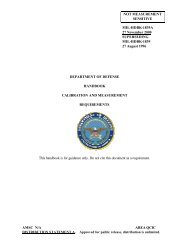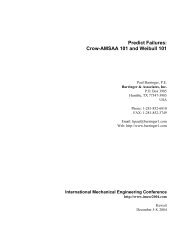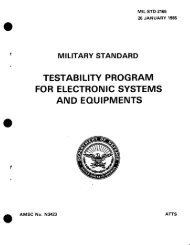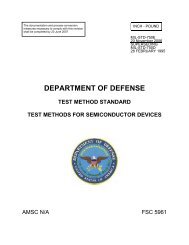Reliability Definitions - Barringer and Associates, Inc.
Reliability Definitions - Barringer and Associates, Inc.
Reliability Definitions - Barringer and Associates, Inc.
Create successful ePaper yourself
Turn your PDF publications into a flip-book with our unique Google optimized e-Paper software.
<strong>Reliability</strong> <strong>Definitions</strong><br />
<strong>Reliability</strong> is an engineering discipline for applying scientific know-how to a component,<br />
assembly, plant, or process so it will perform its intended function, without failure, for<br />
the required time duration when installed <strong>and</strong> operated correctly in a specified<br />
environment.<br />
<strong>Reliability</strong> terminates with a failure—i.e, unreliability occurs. Business enterprises<br />
observe the high cost of unreliability. The high cost of unreliability motivates an<br />
engineering solution to control <strong>and</strong> reduce costs.<br />
Among living organisms, reliability would be studied in terms of survivors. Unreliability<br />
would be studied in terms of mortality.<br />
You may not clearly underst<strong>and</strong> the definition of reliability. However, when your<br />
automobile stop functioning during your mission, you will clearly underst<strong>and</strong> the concept<br />
of unreliability. You’ll also learn about the gut rending reality of the cost of unreliability<br />
when you have your automobile restored to a reliable condition.<br />
MIL-STD-721C <strong>Definitions</strong> of Terms For <strong>Reliability</strong> <strong>and</strong> Maintainability gives two<br />
definitions for reliability:<br />
1. The duration or probability of failure-free performance under stated<br />
conditions<br />
2. The probability than an item can perform its intended function for a<br />
specified interval under stated conditions<br />
(For non-redundant items this is equivalent to definition (1).<br />
For redundant items this is equivalent to definition of mission reliability)<br />
<strong>Reliability</strong> (the absence of failures which defines the probability of the failure free<br />
interval) is often confused with availability (% up time). See the table below for a chance<br />
failure mode, a one year mission time, <strong>and</strong> the failure rate required to achieve the<br />
specified reliability. More details are described for availability ≠ reliability on this<br />
website.
Is<br />
Driven<br />
By<br />
<strong>Reliability</strong> ⇒ Number Of Failures<br />
Reliabililty<br />
Failures per<br />
year<br />
Failures per<br />
10 years<br />
Failures per<br />
100 years<br />
10.00% 2.30<br />
20.00% 1.61<br />
30.00% 1.20<br />
40.00% 0.92<br />
50.00% 0.69<br />
60.00% 0.51<br />
70.00% 0.36<br />
80.00% 0.22 2.23<br />
90.00% 0.11 1.05<br />
95.00% 0.05 0.51<br />
99.00% 0.01 0.10 1.01<br />
99.50% 0.005 0.05 0.50<br />
99.90% 0.001 0.01 0.10<br />
99.99% 0.0001 0.001 0.01<br />
99.999% 0.00001 0.0001 0.001<br />
99.9999% 0.0000010 0.00001 0.0001<br />
99.99999% 0.00000010 0.000001 0.00001<br />
1 yr mission = 365 days/yr * 24 hrs/day = 8760 hrs/yr<br />
Just as a reminder<br />
--these numbers are<br />
based on chance<br />
failures modes <strong>and</strong><br />
#’s can change with<br />
other failure modes!<br />
How many failures<br />
can you afford<br />
How much can you<br />
afford to spend to<br />
avoid failures<br />
For private enterprise production facilities the key issue is preventing failure of the<br />
money making machine called the process. A key problem to quantify is accepting or<br />
denying the risk for failure of the process. Pumps, compressors, valves, <strong>and</strong> computers<br />
will fail according the natural law of entropy; however we must consider alternatives for<br />
achieving a failure free process to key cash flowing for the corporation. So, consider this<br />
practical definition for reliability:<br />
<strong>Reliability</strong> is the probability that a device, system, or process<br />
will perform its prescribed duty without failure for a given time<br />
when operated correctly in a specified environment.<br />
<strong>Barringer</strong> & <strong>Associates</strong>, <strong>Inc</strong>. are reliability consultants solving reliability problems for<br />
industry using engineering, manufacturing, <strong>and</strong> business expertise. We specialize in<br />
solving reliability problems for profit oriented, capital intensive, continuous process<br />
operations. Through our network of reliability experts, we get cost effective engineers<br />
assigned to solve your reliability problems efficiently <strong>and</strong> cost effectively. Our efforts<br />
are driven by the high cost of unreliability. We believe in crass commercialism for<br />
profitable improvements. If the proposed improvements do not provide financial (or<br />
safety) returns, then we reject the improvements as not being worthy of implementation.<br />
Our philosophy is NOT to move in with the client—we want to help clients make
improvements <strong>and</strong> we will teach our clients how to use the science <strong>and</strong> technology of<br />
reliability to make their own improvements as we move along to other tasks.<br />
Our training course in <strong>Reliability</strong> Engineering Principles teaches engineers how to use<br />
equipment failure data to reduce the high cost of unreliability. Failure data drive<br />
reliability-centered maintenance (RCM) programs required for 15-30% of the equipment<br />
which can benefit from RCM <strong>and</strong> we support total productive maintenance (TPM) efforts<br />
for 60-80% of the equipment in most operating plants.<br />
Our training course in Life-Cycle-Cost brings together reliability models, cost details,<br />
installation practices, operating practices, <strong>and</strong> failure data for making good business<br />
decisions. The training course uses Monte Carlo simulations in an Excel spreadsheet to<br />
simulate failures expected each year <strong>and</strong> shows how to cost the results over the life of the<br />
equipment or project. We support extensive up-front reliability <strong>and</strong> maintainability<br />
efforts to reduce the long term cost of ownership.<br />
Our training course in Process <strong>Reliability</strong> teaches engineers how to study their processes<br />
<strong>and</strong> determine the reliability so that losses can be reduced <strong>and</strong> profits increased.<br />
Over 2000 engineers have received training in the <strong>Reliability</strong> Engineering Principles<br />
training course in the USA, Canada, Europe, <strong>and</strong> Asia. The Life-Cycle-Cost training<br />
program integrates business decisions into engineering failure details to show how<br />
equipment <strong>and</strong> projects are managed for the lowest long-term cost of ownership. The<br />
Process <strong>Reliability</strong> training program shows how to use production output data to find<br />
consistency in the process <strong>and</strong> calculates losses from reliability issues <strong>and</strong> from<br />
efficiency/utilization problems. These practical courses use software to solve statistical<br />
problems while we concentrate our training efforts on how to use data, <strong>and</strong> reliabilityengineering<br />
tools cost effectively.<br />
Our software uses Weibull statistics in Monte Carlo models for cost effective business<br />
solutions for reliability <strong>and</strong> availability problems.<br />
We sell Fulton Findings software for Weibull analysis of failure data <strong>and</strong> we use this<br />
software to build Weibull-databases from failure data.<br />
You can download a PDF copy of this page (260K file size).<br />
Return to <strong>Barringer</strong> & <strong>Associates</strong>, <strong>Inc</strong>. homepage<br />
Last revised 3/23/2003


